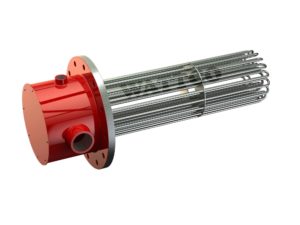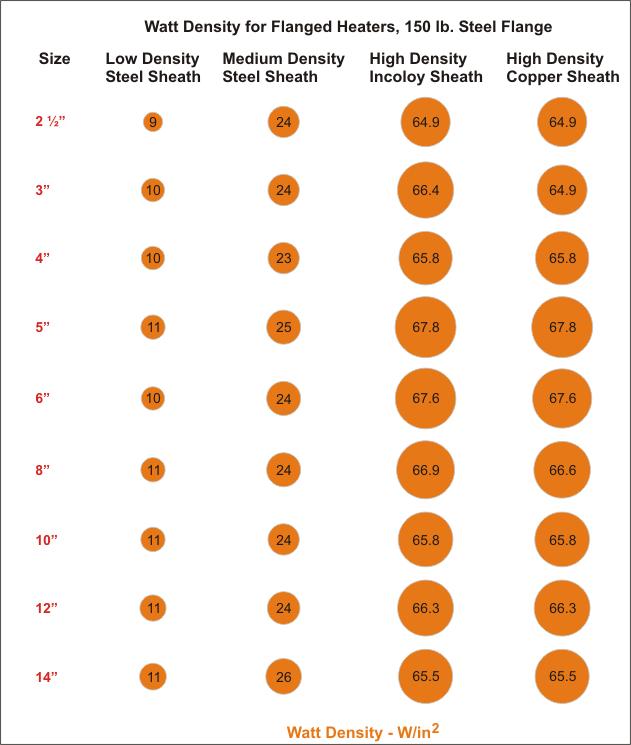What are flanged heaters
WATTCO develops and manufactures a series of flanged immersion heaters used for heating gases and liquids such as: water, oil, and corrosive solutions. WATTCO flanged heaters have hairpin or bent tubular elements. They are manufactured by welding or brazing these heating elements onto a flange. ANSI rated flange, usually made of steel, is ideally suited for industrial process heating. However other materials such as stainless steel are also used. The sheath materials used in heating elements include: steel, stainless steel, copper, and INCOLOY.
WATTCO flanged heaters have hairpin or bent tubular elements. They are manufactured by welding or brazing these heating elements onto a flange. ANSI rated flange, usually made of steel, is ideally suited for industrial process heating. However other materials such as stainless steel are also used. The sheath materials used in heating elements include: steel, stainless steel, copper, and INCOLOY.
Flanged Immersion heaters come with different sheath and flange materials, different operating voltages, power (kilowatts) ratings, and temperature ranges.
For electrical connections, the flanged heaters also consist of terminal boxes of different types. Each type identifies its suitability to different scenarios such as a moist operating environment. For process temperature control, WATTCO provides a thermowell–located among the heating elements bundle–with a sensing bulb inside.
Flange heaters are installed on a tank or vessel wall using a companion flange.
Application
The primary use of flanged immersion heaters is in process heating, specifically for heating gas and liquids in storage tanks, oil containers, food process equipment, and cleaning and rinsing tanks. The direct immersion method is an efficient process. However, the selection of flanged heater depends on 1) evaluating the requirements such as: heat (or watt density), voltages, operating environment such as type of fluid used (water or corrosive solutions) and 2) choosing the most appropriate flanged heater that depends on flange sizes and materials, number of elements, kilowatt ratings, terminal enclosures and sheath materials.
The process engineer applies his/her knowledge and acumen in selecting and installing a flange heater. The flanged heater is usually installed are by bolting it to a matching flange welded to the tank wall or nozzle. The maximum sheath temperature of the element material is a very important parameter. It depends on: 1) viscosity 2) specific density and 3) corrosive properties of the heated medium 4) contaminants present, if any, in the heated medium 5) corrosion resistive properties of the sheath material.

Figure 1: Typical watt density for flanged heaters. Refer to the datasheet for accuracy.
Temperature Monitoring and Control
For flanged heaters, temperature monitoring and control is provided by either mechanical or electronic devices. For temperature control using a mechanical device, the heater housing consists of a thermostat that operates as an on-off temperature control. This thermostat is factory installed. The thermowell is comprised of a sensing bulb that is capable of transmitting the temperature readings to a digital temperature controller to keep the temperature to a desired setting.
A thermocouple is placed inside the thermowell for an electronic-based mechanism of temperature control. The thermocouple is factory installed and is connected to a temperature controller.
Protection from Over Temperature: Flanged heaters also have thermocouples to switch off the heater when the temperature goes above a set value. The thermocouple is mounted on the heating element sheath to provide sheath limit protection and temperature control. In order to switch off the heater, the thermocouple is connected to a high limit sensor temperature controller, which is remotely mounted.
Frequently Asked Questions
What precautions do you need to take against corrosive solutions?
You should make an informed decision about the sheath material based on your knowledge of the chemical composition (and other materials) of the corrosive solution.
When should you use Type E4 terminal box?
Type E4 terminal box refers to explosion-resistant (terminal) housing construction. This type of construction prevents fire or explosion in cases of high temperature application or use. You should order E4 type flanged heater for such scenarios.
